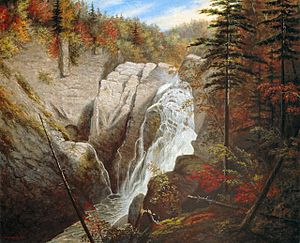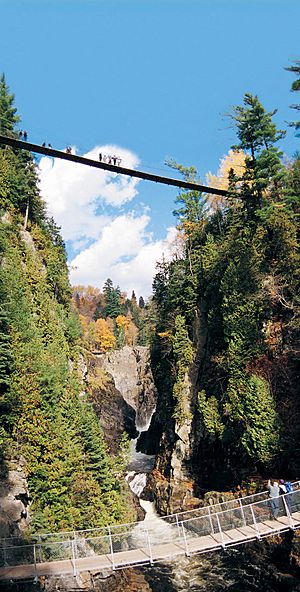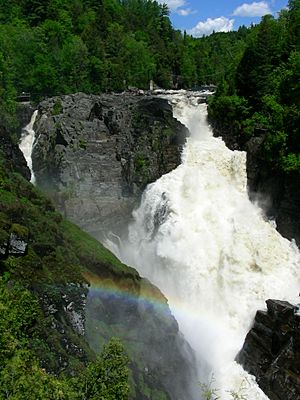Canyon Sainte-Anne facts for kids

Get ready to explore Canyon Sainte-Anne, a super cool and deep gorge! It's carved out by the powerful Sainte-Anne-du-Nord River and is located about 6 kilometers east of Beaupré, Quebec, Canada. The river here plunges down a huge 74 m (243 ft) waterfall right inside the canyon. You can visit this amazing place from May to October each year.
Contents
What You Can See and Do
Over 100,000 people visit Canyon Sainte-Anne every year! It's a fantastic spot for families and adventurers.
Exciting Bridges and Views
You can cross the canyon on three special suspension foot bridges. One of them hangs 60 m (197 ft) high above the river! Imagine looking down from that height! There are also many lookout spots where you can see giant potholes and other smaller waterfalls.
Adventure Activities
If you're feeling brave, you can try rock climbing or via ferrata. Via ferrata is like a climbing path with steel cables and ladders built into the rock. Canyon Sainte-Anne was the first place in Canada to have one! You can also try rappelling down the canyon walls, but only with a guide to keep you safe.
A Place with a Past
People have known about this canyon for a very long time. Native people knew it well. A famous painter named Cornelius Krieghoff even painted the Sainte-Anne Falls way back in 1855. An American writer and nature lover, Henry David Thoreau, also wrote about it. The canyon was even used to film parts of the movie Battlefield Earth in 2000! It opened to the public in 1973.
Where is Canyon Sainte-Anne?
Canyon Sainte-Anne is easy to find! It's about 25 to 30 minutes east of Quebec City. It sits right on the edge of the Beaupré Coast and Charlevoix areas. The canyon is located between the towns of Saint-Ferréol-les-Neiges and Saint-Joachim.
Nearby Attractions
There are many other cool places close by, like:
- The Sainte-Anne-de-Beaupré Basilica, a famous church.
- The Mont Sainte-Anne ski resort, great for winter sports.
- The beautiful Montmorency Falls.
- The Cap Tourmente National Wildlife Reserve, where you can see lots of birds and wildlife.
47°4′23.1″N 70°52′38.6″W / 47.073083°N 70.877389°W
How the Canyon Was Formed
The canyon is part of the Canadian Shield, which is a very old and strong rock foundation found in many parts of Canada.
Ancient Rocks
It all started about 1.2 billion years ago! That's when super hard rocks formed deep inside the Earth. This rock is called granitic gneiss. It was pushed up to the surface over millions of years. Later, about 450 million years ago, ancient seas covered the area. Mud settled on top of the gneiss and turned into a rock called shale. This shale then changed into an even tougher rock called slate. Slate is very strong and can stand up to the power of water.
The Ice Age Sculptors
Much, much later, two huge ice ages covered North America. Giant glaciers moved across the land, carving out valleys and shaping the landscape we see today. When the last ice age ended and the ice melted, the land slowly rose up. The Atlantic Ocean even flowed in for a while, creating a temporary sea called the Champlain Sea. All these changes, along with the river's power, helped create the amazing Canyon Sainte-Anne!
The Story of Its Discovery
In the early 1900s, the Sainte-Anne-du-Nord River was used by loggers to float trees down.
A Hidden Gem
In the summer of 1965, a man named Jean-Marie McNicoll was camping in the area. An old logger told him how to find the Sainte-Anne River falls. There was no road, so Jean-Marie had to hike through the woods. But it was worth it! He found a truly unique and beautiful place. He rushed back to tell his brother Laurent about his amazing discovery.
Opening to the Public
Two years later, Jean-Marie and Laurent leased the land around the river. They also bought the wooded areas nearby. Slowly, they started clearing a road and getting everything ready. Finally, on July 14, 1973, Canyon Sainte-Anne opened its doors to welcome its first visitors!
Images for kids
-
Sainte-Anne Falls, painted by Cornelius Krieghoff, 1855






